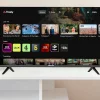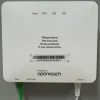Study Warns Starlink Broadband Satellites Causing Problems for Radio Astronomy

A new study conducted by the Netherlands Institute for Radio Astronomy (ASTRON) has warned that interference from the second (v2-Mini) generation of Starlink’s (SpaceX) broadband satellites is around 32 times stronger than their first generation spacecraft, which is causing growing problems for radio astronomy.
Elon Musk’s Starlink network currently has 6,398 LEO satellites (c.2,200 are v2 Mini / GEN 2A) in Low Earth Orbit – mostly at altitudes of c.500-600km – and they’re in the process of adding thousands more by the end of 2027. Customers in the UK typically pay from £75 a month for a 30-day term, plus £299 for hardware on the ‘Standard’ plan (inc. £20 postage), which promises internet latency times of 25-60ms, downloads of c. 25-100Mbps and uploads of c. 5-10Mbps.
However, ASTRON’s new study (here) has found a significant increase in Unintended Electromagnetic Radiation (UEMR) from the second-generation of Starlink satellites, which is often a by-product of the constellations wanted emissions – causing a growing problem for radio astronomy telescopes (i.e. devices that are extremely sensitive to interference, particularly in certain bands).
Advertisement
Radio telescopes, like the LOFAR telescope in the Netherlands that was used for this study, allow scientists to observe the sky and study other galaxies, stars, nebula, planets and black holes etc. across different parts of the electromagnetic spectrum. “Every time more of these [satellites] are launched with these kinds of emission levels, we see less and less of the sky,” said Professor Jessica Dempsey, Director of ASTRON, to the BBC News.
Study Findings (Extract)
We find that the second generation of Starlink satellites that we observed with LOFAR emit higher levels of unintended electromagnetic radiation (UEMR) over a broader frequency range compared to that emitted by the first generation of Starlink satellites. Our observations show that in the 150.05–153 MHz primary radio astronomy band, the broadband UEMR of the second-generation v2-Mini and v2-Mini DTC satellites is, on average, 15 dB and 7 dB brighter than that of the first-generation v1.0 and v1.5 Starlink satellites. On a linear scale, this corresponds to factors of 32 and 5, respectively.
This trend is also present in the 116–124 MHz and 157–165 MHz bands, and in the frequency bands from 50 to 66 MHz where the satellites from the first generation are not detected. On the other hand, the strong narrowband UEMR that is seen in the v1.0 and v1.5 satellites at 125, 135, and 150 MHz appears to be absent in the v2-Mini and v2-Mini DTC satellites. While this is an improvement, it is completely negated by the stronger broadband UEMR, which affects a significantly larger part of the observed frequency range.
The issue of the higher levels of UEMR from the second-generation Starlink satellites is further exacerbated by the lower orbits in which these satellites operate. These satellites are used in the (modified) Generation 2 Starlink constellation, for which the US Federal Communications Commission (FCC) has approved operational orbits at 448 and 482 km for the v2-Mini satellites, and 360 km for the v2-Mini DTC satellites. As a result of these lower orbits and resulting smaller distances to Earth-based telescopes, the signals will be 30–130% brighter compared to the Generation 1 Starlink constellation, which mostly operates at orbital altitudes of 550 km.
The impact of the observed UEMR on radio astronomy will vary between different science cases, although the study foresees a situation where one or more satellites may be present in the telescope’s field of view at any given time and this could hamper or even prevent some observations (i.e. too much interference ruins the usefulness of the data). This is the primary reason why broadband UEMR is particularly worrisome for radio astronomy; it increases the risk that the entire observing bandwidth is affected by UEMR for the entire duration of the observation.
Just for some practical context, the study found that almost all of the observed Starlink v2 Satellites (including Direct to Cell ones) produced unintended electromagnetic radiation, which was about 10 million times brighter than from the weakest sources of light identified and 32 times stronger than Starlink’s first generation spacecraft. The problem will only get worse as SpaceX’s constellation, as well as similar networks, continue to grow.
“This is actually threatening the entirety of ground based astronomy in every wavelength and in different ways. If it continues, without the sort of mitigation to make these satellites quiet, then it does become an existential threat for the kinds of astronomy we do,” Prof Dempsey added.
Advertisement
Starlink aren’t oblivious to this problem and have been actively engaging with researchers to find solutions, although the fact that their latest generation of spacecraft has made the problem worse is not to be overlooked. On the other hand, SpaceX has recently begun introducing a system that enables them to dynamically adjust the Starlink network in order to avoid causing interference for radio telescopes (here), although it’s unclear how many telescope sites will be able to adopt this (it requires a partnership with each one).
In the meantime, the study authors hope that their research may help SpaceX/Starlink to “identify the satellite components involved in the emission of UEMR and devise mitigation strategies in already operational satellites, as well as future designs of the hardware.”
Mark is a professional technology writer, IT consultant and computer engineer from Dorset (England), he also founded ISPreview in 1999 and enjoys analysing the latest telecoms and broadband developments. Find me on X (Twitter), Mastodon, Facebook, BlueSky, Threads.net and Linkedin.
« BT Deal Allows UK ISP Cuckoo to Sell Openreach Broadband Packages Again























































Should we be surprised by the proliferation of RF use = pollution ?